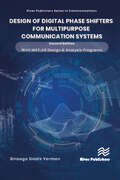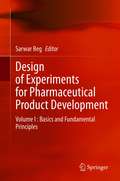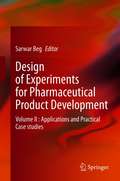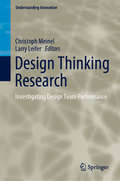- Table View
- List View
Design of Biomedical Devices and Systems, 4th edition
by Paul H. King Richard C. Fries Arthur T. JohnsonThis fourth edition is a substantial revision of a highly regarded text, intended for senior design capstone courses within departments of biomedical engineering, bioengineering, biological engineering and medical engineering, worldwide. Each chapter has been thoroughly updated and revised to reflect the latest developments. New material has been added on entrepreneurship, bioengineering design, clinical trials and CRISPR. Based upon feedback from prior users and reviews, additional and new examples and applications, such as 3D printing have been added to the text. Additional clinical applications were added to enhance the overall relevance of the material presented. Relevant FDA regulations and how they impact the designer’s work have been updated. Features Provides updated material as needed to each chapter Incorporates new examples and applications within each chapter Discusses new material related to entrepreneurship, clinical trials and CRISPR Relates critical new information pertaining to FDA regulations. Presents new material on "discovery" of projects "worth pursuing" and design for health care for low-resource environments Presents multiple case examples of entrepreneurship in this field Addresses multiple safety and ethical concerns for the design of medical devices and processes
Design of Biomedical Devices and Systems Second edition
by Richard C. Fries Paul H. KingThe design and functional complexity of medical devices and systems has increased during the past half century, evolving from the level of cardiac pacemakers to magnetic resonance imaging devices. Such life-saving advancements are monumentally advantageous, but with so much at stake, a step-by-step manual for biomedical engineers is essential. This
Design of Digital Phase Shifters for Multipurpose Communication Systems
by Binboga Siddik YarmanThis book aims to cover a new emerging need in designing digital phase shifter for modern communication systems. With the advancement of new generation mobile communication systems, directed beams of antenna arrays save a substantial amount of power as well as improve the communication quality. In this regard, beam-forming circuits, such as digital phase shifters (DPS) constitute essential parts of the antenna array systems. Therefore, this book is devoted to the design of digital phase shifters for various communications systems. Nowadays, phase array systems demand compact phase shifters suitable for chip implementation with wide phase-range and broad frequency band. Each chapter of this book is organized as stand-alone in such a way that the reader requires no specific background acquired from the other chapters. For each phase shifter topology introduced in this book, the reader is furnished with explicit design equations to construct the circuit under consideration. Furthermore, design equations are programmed using MATLAB to assess the electrical performance of the phase shifters with ideal and lossy components. MATLAB design programs are given at the and of each chapter as appendices and provided as soft copy on the web page of the book. In chapters 12 and 14, MMIC layouts for the lattice and T-section based DPS are provided for the readers. It is hoped that an interested reader can immediately identifies the “optimum phase shifter topology” for the need under consideration with its estimated electric performance.
Design of Digital Phase Shifters for Multipurpose Communication Systems
by Binboga Siddik YarmanThis book aims to cover a new emerging need in designing digital phase shifter for modern communication systems. With the advancement of new generation mobile communication systems, directed beams of antenna arrays save a substantial amount of power as well as improve the communication quality. In this regard, beam-forming circuits, such as digital phase shifters (DPS) constitute essential parts of the antenna array systems. Therefore, this book is devoted to the design of digital phase shifters for various communications systems. Nowadays, phase array systems demand compact phase shifters suitable for chip implementation with wide phase-range and broad frequency band. Each chapter of this book is organized as stand-alone in such a way that the reader requires no specific background acquired from the other chapters. For each phase shifter topology introduced in this book, the reader is furnished with explicit design equations to construct the circuit under consideration. Furthermore, design equations are programmed using MATLAB to assess the electrical performance of the phase shifters with ideal and lossy components. MATLAB design programs are given at the and of each chapter as appendices and provided as soft copy on the web page of the book. In chapters 12 and 14, MMIC layouts for the lattice and T-section based DPS are provided for the readers. It is hoped that an interested reader can immediately identifies the “optimum phase shifter topology” for the need under consideration with its estimated electric performance.
Design of Experiments and Advanced Statistical Techniques in Clinical Research
by Basavarajaiah D. M. Bhamidipati Narasimha MurthyRecent Statistical techniques are one of the basal evidence for clinical research, a pivotal in handling new clinical research and in evaluating and applying prior research. This book explores various choices of statistical tools and mechanisms, analyses of the associations among different clinical attributes. It uses advanced statistical methods to describe real clinical data sets, when the clinical processes being examined are still in the process. This book also discusses distinct methods for building predictive and probability distribution models in clinical situations and ways to assess the stability of these models and other quantitative conclusions drawn by realistic experimental data sets. Design of experiments and recent posthoc tests have been used in comparing treatment effects and precision of the experimentation. This book also facilitates clinicians towards understanding statistics and enabling them to follow and evaluate the real empirical studies (formulation of randomized control trial) that pledge insight evidence base for clinical practices. This book will be a useful resource for clinicians, postgraduates scholars in medicines, clinical research beginners and academicians to nurture high-level statistical tools with extensive scope.
Design of Experiments for Pharmaceutical Product Development: Volume I : Basics and Fundamental Principles
by Sarwar BegThis book volume provides complete and updated information on the applications of Design of Experiments (DoE) and related multivariate techniques at various stages of pharmaceutical product development. It discusses the applications of experimental designs that shall include oral, topical, transdermal, injectables preparations, and beyond for nanopharmaceutical product development, leading to dedicated case studies on various pharmaceutical experiments through illustrations, art-works, tables and figures. This book is a valuable guide for all academic and industrial researchers, pharmaceutical and biomedical scientists, undergraduate and postgraduate research scholars, pharmacists, biostatisticians, biotechnologists, formulations and process engineers, regulatory affairs and quality assurance personnel.
Design of Experiments for Pharmaceutical Product Development: Volume II : Applications and Practical Case studies
by Sarwar BegThis book volume provides complete and updated information on the applications of Design of Experiments (DoE) and related multivariate techniques at various stages of pharmaceutical product development. It discusses the applications of experimental designs that shall include oral, topical, transdermal, injectables preparations, and beyond for nanopharmaceutical product development, leading to dedicated case studies on various pharmaceutical experiments through illustrations, art-works, tables and figures. This book is a valuable guide for all academic and industrial researchers, pharmaceutical and biomedical scientists, undergraduate and postgraduate research scholars, pharmacists, biostatisticians, biotechnologists, formulations and process engineers, regulatory affairs and quality assurance personnel.
Design of Experiments in Nonlinear Models: Asymptotic Normality, Optimality Criteria and Small-Sample Properties (Lecture Notes in Statistics #212)
by Luc Pronzato Andrej PázmanDesign of Experiments in Nonlinear Models: Asymptotic Normality, Optimality Criteria and Small-Sample Properties provides a comprehensive coverage of the various aspects of experimental design for nonlinear models. The book contains original contributions to the theory of optimal experiments that will interest students and researchers in the field. Practitionners motivated by applications will find valuable tools to help them designing their experiments. The first three chapters expose the connections between the asymptotic properties of estimators in parametric models and experimental design, with more emphasis than usual on some particular aspects like the estimation of a nonlinear function of the model parameters, models with heteroscedastic errors, etc. Classical optimality criteria based on those asymptotic properties are then presented thoroughly in a special chapter. Three chapters are dedicated to specific issues raised by nonlinear models. The construction of design criteria derived from non-asymptotic considerations (small-sample situation) is detailed. The connection between design and identifiability/estimability issues is investigated. Several approaches are presented to face the problem caused by the dependence of an optimal design on the value of the parameters to be estimated. A survey of algorithmic methods for the construction of optimal designs is provided.
Design of Self-Assembling Materials
by Ivan ColuzzaThis book provides in-depth insights into assembling dynamics of proteins, DNA and other nanoparticles. The applications of basic knowledge in the development of artificial self-assembling systems will be discussed and state of the art methodology in the field will be presented.This interdisciplinary work brings together aspects of different fields of expertise such as Biology, Physics and Material Sciences and is intended for researchers, professors and graduate students interested in the design of self-assembling materials.
The Design of Studies for Medical Research
by David Machin Michael J. CampbellThe same careful rigour imposed on the design of phase III randomised controlled trials is not always applied to medical research in other areas such as trials conducted at earlier stages of drug development. With the emphasis that is now placed on evidence-based medicine, such care and rigour will inevitably impact on these areas with increasing attention turned to the quality of design. This title describes what principles can be used to structure research effectively allowing for the required degree of accuracy. Written by two best selling authors, this book includes many examples from medical literature and will be of great value to all groups conducting studies at the interface of clinical and laboratory research.
The Design of Synthetic Inhibitors of Thrombin (Advances in Experimental Medicine and Biology #340)
by Göran Claeson Michael F. Scully Vijay V. Kakkar John DeadmanIn one generation, the numerous factors involved in blood coagulation have become real protein entities, isolated in pure form, expressed by recombinant DNA techniques, and subjected to structure elucidation by the modem methods of physical chemistry, viz. , X-ray diffraction, and NMR, ESR and fluorescence spectroscopy. The major milestone in this field was the breakthrough achieved by W. Bode, R. Huber and their colleagues in 1989 in of human a-thrombin, inhibited with D-Phe-Pro-Arg determining the crystal structure chioromethyl ketone. The availability of this structure will greatly facilitate the interpretation of experiments designed to gain an understanding of the interatomic interactions between this enzyme and fibrinogen and its other substrates. At the same time, it provides a rational basis for the design and synthesis of inhibitors of thrombin, the subject of this symposium. The symposium was organized in four sessions: (1) Structural features of the interaction of thrombin with substrates and inhibitors, (2) Synthetic inhibitors, (3) Hirudin and its analogues, and (4) Pharmacological and clinical considerations. This book contains summaries of most of the papers presented, and takes its rigbful place among two others that provide a comprehensive picture of our current knowledge about thrombin, viz. the 1977 volume entitled "Chemistry and Biology of Thrombin", edited by R. L. Lundblad, J. W. Fenton II, and K. G. Mann, and the 1992 volume entitled "Thrombin: Structure and Function", edited by L. J. Berliner.
Design, Synthesis, Multifunctionalization and Biomedical Applications of Multifunctional Mesoporous Silica-Based Drug Delivery Nanosystems (Springer Theses)
by Yu ChenThis thesis reports on essential advances in the design, synthesis and biomedical applications of multifunctional Mesoporous Silica Nanoparticles (MSNs). It provides several examples of multifunctional MSN-based drug delivery nanosystems and demonstrates successful synergistic cancer therapies combining MSNs and high-intensity focused ultrasound. The book will especially be of interest to researchers and graduate students in the fields of biomaterials, biology, chemistry, medicine and the life sciences who are working to develop new methods and technologies to combat cancer.
Design That Cares: Planning Health Facilities for Patients and Visitors (J-B AHA Press #142)
by Janet R. Carpman Myron A. GrantDesign That Cares: Planning Health Facilities for Patients and Visitors, 3rd Edition is the award-winning, essential textbook and guide for understanding and achieving customer-focused, evidence-based health care design excellence. This updated third edition includes new information about how all aspects of health facility design – site planning, architecture, interiors, product design, graphic design, and others - can meet the needs and reflect the preferences of customers: patients, family and visitors, as well as staff. The book takes readers on a journey through a typical health facility and discusses, in detail, at each stop along the way, how design can demonstrate care both for and about patients and visitors. Design that Cares provides the definitive roadmap to improving customer experience by design.
Design That Cares: Planning Health Facilities for Patients and Visitors (J-B AHA Press #142)
by Janet R. Carpman Myron A. GrantDesign That Cares: Planning Health Facilities for Patients and Visitors, 3rd Edition is the award-winning, essential textbook and guide for understanding and achieving customer-focused, evidence-based health care design excellence. This updated third edition includes new information about how all aspects of health facility design – site planning, architecture, interiors, product design, graphic design, and others - can meet the needs and reflect the preferences of customers: patients, family and visitors, as well as staff. The book takes readers on a journey through a typical health facility and discusses, in detail, at each stop along the way, how design can demonstrate care both for and about patients and visitors. Design that Cares provides the definitive roadmap to improving customer experience by design.
Design Thinking in Healthcare: From Problem to Innovative Solutions
by Anni Pakarinen Thomas Lemström Eeva Rainio Eriikka SiiralaThis book offers basic knowledge on Design Thinking as a method, process and philosophy. It presents thoughtful Design Thinking case examples and tools for nurses and other healthcare professionals, researchers, students and educators to support their development as creative and transformative leaders in their fields.Healthcare managers of the past viewed patients’ needs merely as targets for population-level health outcomes to be validated in the final phases of developing interventions and services. Today we know better. Patients’ needs and experiences should be viewed as sources of innovation at the front-end of the development process. It provides the basis for applying design thinking to develop better healthcare services and health tech applications.Today, the success of any healthcare service depends on complex interactions between various stakeholders, and new solutions can only be delivered effectively through co-creative and collaborative efforts. Coordinating such efforts relies on strong concepts that can only result from properly run design processes, that this book describes in light of case studies around the world.Design thinking is crucial generalist skill and is receiving increasing attention in the field, as forward-thinking organizations delve into the practice. It can change the way medical solutions are created and how clinical services are delivered. By driving innovation by means of empathy and practicality, design thinking provides tools for those seeking to drive radical renewal in the field.
Design Thinking Research: Investigating Design Team Performance (Understanding Innovation)
by Christoph Meinel Larry LeiferExtensive research conducted by the Hasso Plattner Design Thinking Research Program at Stanford University in Palo Alto, California, USA, and the Hasso Plattner Institute in Potsdam, Germany, has yielded valuable insights on why and how design thinking works. The participating researchers have identified metrics, developed models, and conducted studies, which are featured in this book, and in the previous volumes of this series.Offering readers a closer look at design thinking, and its innovation processes and methods, this volume addresses the new and growing field of neurodesign, which applies insights from the neurosciences in order to improve design team performance. Thinking and devising innovations are inherently human activities – and so is design thinking. Accordingly, design thinking is not merely the result of special courses or of being gifted or trained: it is a way of dealing with our environment and improving techniques, technologies and life in general. As such, the research outcomes compiled in this book are intended to inform and provide inspiration for all those seeking to drive innovation – be they experienced design thinkers or newcomers.
Design Thinking Research: Interrogating the Doing (Understanding Innovation)
by Christoph Meinel Larry LeiferExtensive research conducted by the Hasso Plattner Design Thinking Research Program at Stanford University in Palo Alto, California, USA, and the Hasso Plattner Institute in Potsdam, Germany, has yielded valuable insights on why and how design thinking works. The participating researchers have identified metrics, developed models, and conducted studies, which are featured in this book, and in the previous volumes of this series. This volume provides readers with tools to bridge the gap between research and practice in design thinking with varied real world examples. Several different approaches to design thinking are presented in this volume. Acquired frameworks are leveraged to understand design thinking team dynamics. The contributing authors lead the reader through new approaches and application fields and show that design thinking can tap the potential of digital technologies in a human-centered way. In a final section, new ideas in neurodesign at Stanford University and at Hasso Plattner Institute in Potsdam are elaborated upon thereby challenging the reader to consider newly developed methodologies and provide discussion of how these insights can be applied to various sectors. Special emphasis is placed on understanding the mechanisms underlying design thinking at the individual and team levels. Design thinking can be learned. It has a methodology that can be observed across multiple settings and accordingly, the reader can adopt new frameworks to modify and update existing practice. The research outcomes compiled in this book are intended to inform and provide inspiration for all those seeking to drive innovation – be they experienced design thinkers or newcomers.
Design Thinking Research: Translation, Prototyping, and Measurement (Understanding Innovation)
by Christoph Meinel Larry LeiferExtensive research conducted by the Hasso Plattner Design Thinking Research Program at Stanford University in Palo Alto, California, USA, and the Hasso Plattner Institute in Potsdam, Germany, has yielded valuable insights on why and how design thinking works. The participating researchers have identified metrics, developed models, and conducted studies, which are featured in this book, and in the previous volumes of this series. This volume provides readers with tools to bridge the gap between research and practice in design thinking with varied real world examples. Several different approaches to design thinking are presented in this volume. Acquired frameworks are leveraged to understand design thinking team dynamics. The contributing authors lead the reader through new approaches and application fields and show that design thinking can tap the potential of digital technologies in a human-centered way. In a final section, new ideas in neurodesign at Stanford University and at Hasso Plattner Institute in Potsdam are elaborated upon thereby challenging the reader to consider newly developed methodologies and provide discussion of how these insights can be applied to various sectors. Special emphasis is placed on understanding the mechanisms underlying design thinking at the individual and team levels. Design thinking can be learned. It has a methodology that can be observed across multiple settings and accordingly, the reader can adopt new frameworks to modify and update existing practice. The research outcomes compiled in this book are intended to inform and provide inspiration for all those seeking to drive innovation – be they experienced design thinkers or newcomers.
Design Thinking Research: Achieving Real Innovation (Understanding Innovation)
by Christoph Meinel Larry LeiferExtensive research conducted by the Hasso Plattner Design Thinking Research Program at Stanford University in Palo Alto, California, USA, and the Hasso Plattner Institute in Potsdam, Germany, has yielded valuable insights on why and how design thinking works. The participating researchers have identified metrics, developed models, and conducted studies, which are featured in this book, and in the previous volumes of this series. This volume provides readers with tools to bridge the gap between research and practice in design thinking with varied real world examples. Several different approaches to design thinking are presented in this volume. Acquired frameworks are leveraged to understand design thinking team dynamics. The contributing authors lead the reader through new approaches and application fields and show that design thinking can tap the potential of digital technologies in a human-centered way. It also presents new ideas in neurodesign from Stanford University and the Hasso Plattner Institute in Potsdam, inviting the reader to consider newly developed methods and how these insights can be applied to different domains. Design thinking can be learned. It has a methodology that can be observed across multiple settings and accordingly, the reader can adopt new frameworks to modify and update existing practice. The research outcomes compiled in this book are intended to inform and provide inspiration for all those seeking to drive innovation – be they experienced design thinkers or newcomers.
Design Thinking Research: Innovation – Insight – Then and Now (Understanding Innovation)
by Christoph Meinel Larry LeiferExtensive research conducted at the Hasso Plattner Design Thinking Research Program at Stanford University in Palo Alto, California, USA, and at the Hasso Plattner Institute in Potsdam, Germany, has yielded valuable insights on why and how design thinking works. The participating researchers have identified metrics, developed models, and conducted studies, which are featured in this book and in the previous volumes of this series. This volume provides readers with tools to bridge the gap between research and practice in design thinking, together with a range of real-world examples. Several different approaches to design thinking are presented, while acquired frameworks are employed to understand team dynamics in design thinking. The contributing authors introduce readers to new approaches and fields of application and show how design thinking can tap the potential of digital technologies in a human-centered way. The book also presents new ideas on neuro-design from Stanford University and the Hasso Plattner Institute in Potsdam, inviting readers to consider newly developed methods and how these insights can be applied to different domains. Design thinking can be learned. It has a methodology that can be observed across multiple settings. Accordingly, readers can adopt new frameworks to modify and update their current practices. The research outcomes gathered here are intended to inform and provide inspiration for all those seeking to drive innovation – be they experienced design thinkers or newcomers. It is the last in a series of 14 volumes published over the past 14 years, reflecting the successes of the HPI-Stanford Design Thinking Research Program. Many thanks to the Hasso Plattner Foundation for its valued support.
Designed Technologies for Healthy Aging (Synthesis Lectures on Assistive, Rehabilitative, and Health-Preserving Technologies)
by Claudia B. RebolaDesigned Technologies for Healthy Aging identifies and presents a variety of contemporary technologies to support older adults’ abilities to perform everyday activities. Efforts of industry, laboratories, and learning institutions are documented under four major categories: social connections, independent self care, healthy home and active lifestyle. The book contains well-documented and illustrative recent examples of designed technologies—ranging from wearable devices, to mobile applications, to assistive robots— on the broad areas of design and computation, including industrial design, interaction design, graphic design, human-computer interaction, software engineering, and artificial intelligence.
Designed to Kill: The Case Against Weapons Research (Research Ethics Forum #1)
by John ForgeThe pilot-less drones, smart bombs and other high-tech weapons on display in recent conflicts are all the outcome of weapons research. However, the kind of scientific and technological endeavour has been around for a long time, producing not only the armaments of Nazi Germany and the atomic bombs dropped on Japan, but the catapults used in ancient Greece and Rome and the assault rifles used by child soldiers in Africa. In this book John Forge examines such weapons research and asks whether it is morally acceptable to undertake such an activity. He argues that it is in fact morally wrong to take part in weapons research as its primary purpose is to produce the means to harm others, and moreover he argues that all attempts to then justify participation in weapons research do not stand up to scrutiny. This book has wide appeal in fields of philosophy and related areas, as well to a more general audience who are puzzled about the rate at which new weapons are accumulated.
Designer Receptors Exclusively Activated by Designer Drugs (Neuromethods #108)
by Gerald ThielThis volume provides current methods to analyze the properties of designer receptors exclusively activated by designer drugs (DREADDs) in vitro and to measure the biological responses of DREADD activation in different neuronal populations in vivo. Chapters focus on the utility of DREADD technology to selectively stimulate or inhibit neuronal activity in selected brain areas of transgenic mice. In addition, the successful use of DREADD expression in rats and Drosophila is described. Together, the DREADD technology represents a non-invasive, chemical-genetic tool for investigating neuronal signaling and the resulting behavioural responses in vivo. Written in the popular Neuromethods series style, chapters include the kind of detail and key advice from the specialists needed to get successful results in your own laboratory. Concise and easy-to-use, Designer Receptors Exclusively Activated by Designer Drugs aims to ensure successful results in the further study of this vital field.
Designing a Better Day: Guidelines for Adult and Dementia Day Services Centers
by Keith Diaz Moore Lyn Dally Geboy Gerald D. WeismanAs the U.S. population ages, adult day services have become an integral component in the continuum of care for elderly people. Providing a variety of social and medical services for cognitively or physically impaired elderly people who otherwise might reside in institutions, these facilities can be found in a variety of building types, from purpose-built facilities to the proverbial church basement. They also vary widely in their philosophies, case mix, funding mechanisms, and services. In this interdisciplinary study, Keith Diaz Moore, Lyn Dally Geboy, and Gerald D. Weisman offer guidance for planning and designing good-quality adult day services centers. They encourage architects, caregivers, and staff members to think beyond the building, organizational mission, and staffing structure to conceive of the place that emerges as an interrelated system of people, programming, and physical setting. Through case studies, thoughtful explanations, and well-crafted illustrations, Designing a Better Day provides caregivers, architects, and administrators tools with which they can make qualitative changes for participants and their families. Organized into three parts—creating awareness, increasing understanding, and taking action—this book will be a key resource for professionals involved in creating and maintaining effective adult day services centers.
Designing a More Inclusive World
by Simeon Keates John Clarkson Patrick Langdon Peter RobinsonDesigning inclusively is no longer an option for companies. It is a business essential. Global populations are getting older, legislation is increasingly prohibitive of unnecessary exclusion and consumer attitudes are beginning to change. Exclusivity is out, inclusivity is in. Research communities the world over are responding to this change in design emphasis. Conferences such as the Cambridge Workshops on Universal Access and Assistive Technology (CWUAAT) offer a forum for researchers from diverse and varied disciplines to bring their perspectives on inclusive design together. This book has been inspired by the second CWUAAT, held in Cambridge, England in March 2004. It contains chapters from an international group of leading researchers in this field. Contributions focus on the following topics: design issues for universal access and assistive technology; enabling computer access and new technologies; and, assistive technology and rehabilitation robotics. This series of conferences is aimed at a broad range of interests, with a general focus on the development of products and solutions. Numerous case studies are used to raise awareness of the challenges faced in developing truly inclusive products, along with examples of good practice for design for a more inclusive world.






















